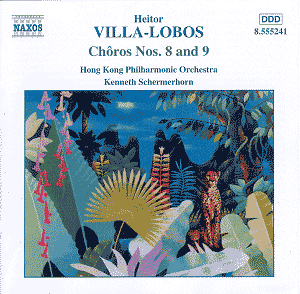 |
Heitor VILLA-LOBOS (1887-1959)
Crotchet AmazonUK AmazonUS Amazon recommendations |
Villa-Lobos was a prolific composer. While living in Paris between 1925 and 1930, he wrote fourteen Chôros for various combinations, all based on Brazilian popular songs and dances. Their tunefulness and infectious rhythms are similar to those found in his more often played Bachianas Brasileiras. While they reflect the interest of twentieth-century composers such as Stravinsky, Vaughan Williams, Britten and Copland, in traditional and popular music, Villa-Lobos uses these influences more as a point of departure for works of a highly structured nature. Indeed, in places these two Chôros are more reminiscent of twentieth-century Paris than Rio, yet they reflect the light-hearted sensuality of their origins in the vivid and colourful culture that inspired them.
No. 8, a dance Chôros, has a carnival atmosphere with moments of rare tranquillity. The large orchestra includes a section of Brazilian instruments, such as the caracxa, reco-reco, cuisa, and matraca, and an assortment of rattles, scrapers and drums (some of which are heard in the insistent rhythm of the opening bars) backed up by three pianos (the first used as a solo instrument), saxophone, double bassoon and orchestral percussion. The debt to Stravinsky is obvious in the barbaric intensity of the music, but it grows so naturally out of its material that this does not affect its originality.
No. 9, written when Villa-Lobos had already decided to leave Paris, has a more relaxed, even mysterious, feeling. What the composer meant when he said that it contained "no fiction, no memories and no transfigured thematic factors, just rhythm and mechanical sounds" is somewhat opaque. It might well have been no more than a gentle jibe at some of his Paris contemporaries, for the style is melodically and rhythmically vivid. The syncopated energy of the piece and its reflective passages certainly do not sound mechanical. Brazilian instruments are again used in a few episodes, as in the quirky waltz that smacks of pastiche.
The Chôros did much to spread the reputation of a composer who, nowadays, does not always receive the attention he merits from audiences looking for "something new", and different from the established Central European schools. This is not, in any narrow sense, "nationalist" music, or clever arrangements of traditional songs and dances. The Hong Kong players give it the careful, yet freewheeling treatment it demands, and Schermerhorn grasps his opportunities with both hands.
Roy Brewer